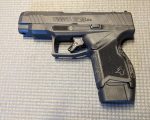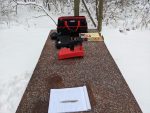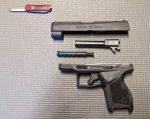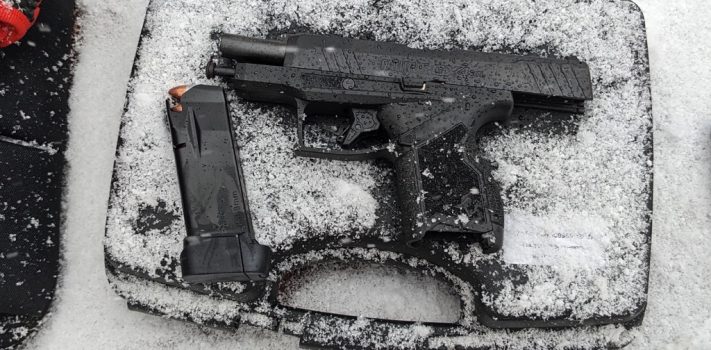I was recently able to test the new Taurus GX4XL EDC variant pistol in 9mm. I was impressed by the way Taurus was able to squeeze a 13-round magazine and a 3.6 inch barrel into a micro-compact profile. The grip texturing was highly effective, and the gas nitride finish on the slide and the diamond-like-coating (DLC) on the stainless steel barrel enhance reliability and wear resistance. Practical accuracy was adequate for a micro-compact profile handgun. With a manufacturer-suggested retail price of $429 for the basic model and widely available online for under $350 at the time of this writing, the GX4XL offers a good option for everyday carry.
A Pleasant Surprise
I had first asked to borrow a sample of the GX4XL several months ago. At that time, Taurus was backordered on the handgun. They promised to send one to my FFL when they had enough in stock to allow them to do so. I stopped by my FFL recently to pick up a different firearm, and was pleasantly surprised to find the GX4XL waiting for me as well.
First Impressions
 Taurus sent me both the standard GX4XL and the Taurus Optic Ready Option (T.O.R.O.) kit. The T.O.R.O. kit contains a slide designed to accommodate a number of different models of micro-red dot sights as well as a second recoil spring and barrel. The case that comes with the GX4XL is made of a decent gauge of plastic with well-designed latches. It won’t need to be quickly replaced like the cardboard boxes or flimsy plastic cases that accompany many new handguns.
Taurus sent me both the standard GX4XL and the Taurus Optic Ready Option (T.O.R.O.) kit. The T.O.R.O. kit contains a slide designed to accommodate a number of different models of micro-red dot sights as well as a second recoil spring and barrel. The case that comes with the GX4XL is made of a decent gauge of plastic with well-designed latches. It won’t need to be quickly replaced like the cardboard boxes or flimsy plastic cases that accompany many new handguns.
The grip texturing on the handle of the GX4XL is excellent, providing a great combination of comfort and secure grip under a wide variety of conditions. The same texturing is used on a pair of indexing pads on the sides of the frame. These indexing pads provide tactile reference points for safe trigger-finger placement outside the trigger guard.
I found the iron sights of the GX4XL somewhat difficult to acquire under low-light conditions. It is good to know that tritium night sights are an upgrade option.
The pistol comes with two sturdily-built, steel Mec-Gar magazines. One of the magazines holds 11 rounds, and the other holds 13. Both magazines insert and remove smoothly and easily from the handgun.
I found the flat-face, safety-blade trigger to be a bit stiff at first. It was so stiff, in fact, that the first time that I attempted to dry fire the pistol I wondered if there was an engaged manual safety somewhere that I did not know about. The trigger became gradually less stiff after cocking and dry-firing the pistol a couple of hundred times. It still remains a bit on the heavy side, although it does break crisply with no creep.
In addition to the usual lock, manual, warranty cards and ads, the case contained an alternate backstrap for the grip, and an optional pinky rest for the 11-round magazine. I decided to just use the 13-round magazine throughout my testing, since the 11-round magazine would provide too small of a grip for someone with hands that are my size.
Reading the Manual
The 40 page manual was well written in a readable font with appropriate illustrations. The manual was redundant in many places with safety warnings that exactly reproduced information that was included in the surrounding text. This helps to emphasize important points, but also tends to cause the eyes of the reader to glaze over.
One interesting detail from the manual is that Taurus recommends generally carrying the pistol in what is commonly known as “Condition 3″ or “Israeli Carry.” This involves inserting a loaded magazine into the handgun but leaving the chamber empty. People have a wide range of very strongly-held opinions about the optimal condition in which to carry a handgun. I was impressed that Taurus was willing to publically enter this debate by making a formal recommendation on this matter. The “condition” debate is akin to declaring that 9mm is better than .45 ACP, or that AKs are better than ARs. Taurus is to be commended for the courage of their convictions. Whether it was wise to publically state those convictions is an entirely different question.
Range Session 1
It was a cloudy day in mid-December. The temperature was about 30 degrees Fahrenheit. There was little wind. A light snow was sifting pretty much straight down.
I pulled on my insulated canvas coveralls, put a jeep cap on my head, and headed to the informal at-home range behind the pole barn. I put some targets up in front of the backstop, and then set up a table 15 yards away.

 I started out by loading 10 rounds of Blazer aluminum-cased 115 grain FMJ ammo into the 13 round magazine of the GX4XL. That was easier said than done. The magazine spring was extremely stiff. I think it was Pat Cascio who suggested loading a magazine with a stiff spring two weeks prior to first use and then allowing it to sit. I wished that I had given this magazine that treatment. I struggled with loading the magazine throughout the range session. I was using the 13-round magazine because the 10-round magazine would be too short for me to grip well without the pinky rest.
I started out by loading 10 rounds of Blazer aluminum-cased 115 grain FMJ ammo into the 13 round magazine of the GX4XL. That was easier said than done. The magazine spring was extremely stiff. I think it was Pat Cascio who suggested loading a magazine with a stiff spring two weeks prior to first use and then allowing it to sit. I wished that I had given this magazine that treatment. I struggled with loading the magazine throughout the range session. I was using the 13-round magazine because the 10-round magazine would be too short for me to grip well without the pinky rest.
I started out by firing a single round from rest at 15 yards. It hit on paper, so I fired the remaining 9 rounds in the magazine. The resulting group was not especially tight.
I next tried 10 rounds of Winchester white box 115-grain FMJ. I was wearing gloves, and was pleased to discover that the trigger guard of the GX4XL was sufficiently large to comfortably accommodate the gloves. This second group was very similar to the first group in terms of accuracy.
By this time the light snow had developed into a moderately heavy snow shower. Enough snow was accumulating on my notepad that I had to shake it off every time I wanted to write something. The traces of moisture left by the snow made it difficult to write legibly.
I switched back to the Blazer ammo, and fired a series of 10-shot groups. The groups varied in size from just under 4 inches to just over 5 inches.
First Cleaning
By this time, enough snow had melted on the warm slide that a immediate and thorough cleaning was in order. I started out by wiping off as much moisture as I could with a rag.
 Disassembling the GX4XL involves using a screwdriver to turn the slotted head of the takedown pin, pulling the trigger, and then pulling the slide off the front of the frame. I used the screwdriver on my Victorinox Classic SD Swiss Army knife to turn the takedown pin. I know that many handguns require the use of tools and/or pulling the trigger during the disassembly process. All other things being equal, I prefer tool-free disassembly that does not involve pulling the trigger. Other than those two details, the cleaning process was straightforward, and reassembly was easy.
Disassembling the GX4XL involves using a screwdriver to turn the slotted head of the takedown pin, pulling the trigger, and then pulling the slide off the front of the frame. I used the screwdriver on my Victorinox Classic SD Swiss Army knife to turn the takedown pin. I know that many handguns require the use of tools and/or pulling the trigger during the disassembly process. All other things being equal, I prefer tool-free disassembly that does not involve pulling the trigger. Other than those two details, the cleaning process was straightforward, and reassembly was easy.
Range Session 2
A couple of days later, I went out to the range again. For this session, I removed the standard slide, barrel, and recoil spring from the GX4XL, and installed the T.O.R.O. kit instead.
It was a gray afternoon the week before Christmas. It was 28 degrees Fahrenheit with no precipitation and no wind.
It was difficult to get the first round to feed from the magazine into the chamber. It kept sticking on the feed ramp or partway into the chamber. I removed the magazine and reloaded it with a number of different cartridges without success. Finally, I just left the magazine out, loaded the first round directly into the chamber, and then inserted the magazine with the remaining rounds. After that first shot, all remaining rounds chambered well.
I fired a series of 10-shot groups from 15 yards. The groups varied from 3.87 to 3.5 inches in size.
 For comparison, I also fired a 10-shot group from 15 yards using my Rock Island Armory full-sized MAPP. That group was 2.81 inches in size. The hits in the groups from the GX4XL had been pretty evenly spread out. The group from the MAPP consisted of 6 hits that made one ragged hole, 3 hits that were very close to the ragged hole, and 1 flyer. A full-sized handgun will typically be much more accurate than a micro-compact design. I fired the MAPP alongside the GX4XL in order to provide a frame of reference for evaluating my relative skill (or lack thereof) when evaluating the accuracy of the GX4XL.
For comparison, I also fired a 10-shot group from 15 yards using my Rock Island Armory full-sized MAPP. That group was 2.81 inches in size. The hits in the groups from the GX4XL had been pretty evenly spread out. The group from the MAPP consisted of 6 hits that made one ragged hole, 3 hits that were very close to the ragged hole, and 1 flyer. A full-sized handgun will typically be much more accurate than a micro-compact design. I fired the MAPP alongside the GX4XL in order to provide a frame of reference for evaluating my relative skill (or lack thereof) when evaluating the accuracy of the GX4XL.
I was interested to find a review of the GX4XL online that reports consistent 2.5-inch five-shot groups from 15 yards using 124-grain FMJ ammo. That review provoked a number of reflections:
1. The author of that review is almost certainly a better shot than I am.
2. The GX4XL may be more accurate with 124-grain ammo than it is with 115-grain ammo.
3. Maybe I should shoot 5-shot groups rather than 10-shot groups when I am testing handguns.
Conclusions
The Taurus GX4XL squeezes a lot of gun into a small package at a reasonable price. If you are in the market for a micro-compact handgun, the GX4XL is worthy of consideration.
Disclaimer
Taurus loaned me a sample of their GX4XL EDC pistol for testing and evaluation. I tried not to allow their kindness to influence my objectivity, and believe that I have succeeded. More than two years ago, Rock Island Armory loaned me a sample of their full-sized MAPP for testing and evaluation. I liked the MAPP so much that I later purchased it. I did not receive any other financial or other inducements from any manufacturer, vendor, or supplier in return for mentioning them. This is a simple factual account of my own experiences: good, bad, or indifferent.










